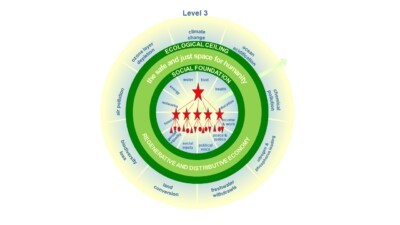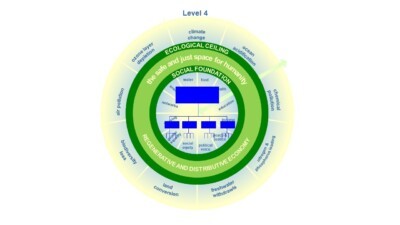Thought Experiment 3 Ethnocentric Worldview: Spiral Dynamics, Integral City & Doughnut Economics
We continue our Thought Experiment in this instalment by looking at Doughnut Economics (DE) and its relationship to Spiral Dynamics and Integral City through an Ethnocentric Worldview.

As we noted in our first blog, the Ethnocentric Worldview spans Levels 3 and 4 in Spiral Dynamics (see Table 3). An ethnocentric worldview embraces the structures of Dominator Hierarchy and Ordering Bureaucracy
Table 3: Ethnocentric Worldview, Spiral Dynamics, Archetypal Structure
WorldviewSpiral Dynamics Level of ComplexitySpiral Dynamics ExpressionArchetypal StructureEthnocentricLevel 3Red – IndividualDominator HierarchyLevel 4Blue – CollectiveOrdering BureaucracyWe can summarize the inner qualities and outer contexts of these 2 levels complexity as set out in Figures 5 and 6.
Figure 5

Figure 6

As we are examining the correlative life conditions that Doughnut Economics points to, we can imagine historically, that the inner and outer factors of DE live within the balance of the Ecological Ceiling and Social Justice factors. Historically, the kinds of human settlements that emerged at these stages were what we would now call traditional towns and cities living in balance with (albeit starting to stretch) the local life conditions.
At the third level of complexity, DE Inner factors included building on the life conditions of earlier levels and added energy (fossil-fuel) plus concerns for Income and Work and developing a Political Voice. Outer factors added to the earlier factors, fresh water drawdown, land use conversions (e.g., forests to farmland), biodiversity loss (as natural habitats were invaded by human settlements.
The Level 3/Red Spiral Dynamic factors were oriented to the individual with the focus on power and exploiting the basics of life in service to the head of the hierarch to protect labour, rent and servitude in exchange for energy (fossil fuel), food, water and health, housing and land. The Human System Context that set the life conditions at this level of complexity were a dominator hierarchy, with a ruler (chief, tyrant) who had the power to overrule and control the faith system, invade and capture the territory of others and claim ownership of land, water and air sheds.
At the fourth level of complexity, DE Inner factors expanded from the third level’s factors to include education, health, social equity (within a hierarchy), gender equity (with male dominance) as human systems became more complex. Outer factors stabilized and even expanded (because of Level 4’s management capacity) to include fresh water, land, biodiversity.
The Level 4/Blue Spiral Dynamic factors are oriented to the collective with the worldview still ethnocentric and expanded beyond the dominator hierarchy to the nation with an organized bureaucracy that can set standards, create rules and enforce compliance to social norms. In this 4th level of complexity resources are distributed through state influence systems for energy (fossil fuels), food, water, health, housing and land/property ownership. The Human System Context that set the life conditions at this level of complexity are capitalist, communist or socialist, with substantive rules-based bureaucratic (civil service) control, unionized work force, peace/order/good government, management protocols for conquered territory (aka colonies), expanded management of land, water, air rights.
Thus, DE helps to situate the emergence of Social Justice factors at the developing stages of human history when the Ecological Ceiling was intended to be managed (in service to the colonizing capabilities developed at the 3rd and 4th stages, and because human populations tended to be managed within circumscribed geographic territories (that had been conquered).
Looking at human habitations in 21st century, at these 3rd and 4th stages, we can consider the implications that these worldviews and capacities have had on the effectiveness of economies. The power that is amplified when territory is conquered and then colonized, managed and organized means that Social Justice factors tend to favour those of the conquering people. These worldviews tended not to care about the reduced availability of Ecological resources for anyone except themselves.
These more complex human settlements created the conditions where it was possible to accumulate enough local wealth that the next stages could ignore the danger of not living within the Ecological Ceilings and/or ignoring Social Justice factors for all people (conquerors and conquered alike).
This series of Thought Experiments consider: How do the Spiral Dynamics integral worldviews of humans living in cities impact the Social Justice and Ecological Ceiling dimensions represented in Doughnut Economics? The blog series includes the following:
Integral City Thought Experiment 1: Exploring Doughnut Economics & Spiral DynamicsThought Experiment 2 Egocentric Worldview: Spiral Dynamics, Integral City & Doughnut EconomicsThought Experiment 3 Ethnocentric Worldview: Spiral Dynamics, Integral City & Doughnut EconomicsThought Experiment 4 Regionalcentric Worldview: Spiral Dynamics, Integral City & Doughnut EconomicsThought Experiment 5 Globalcentric Worldview: Spiral Dynamics, Integral City & Doughnut EconomicsMarilyn Hamilton's Blog
- Marilyn Hamilton's profile
- 3 followers



